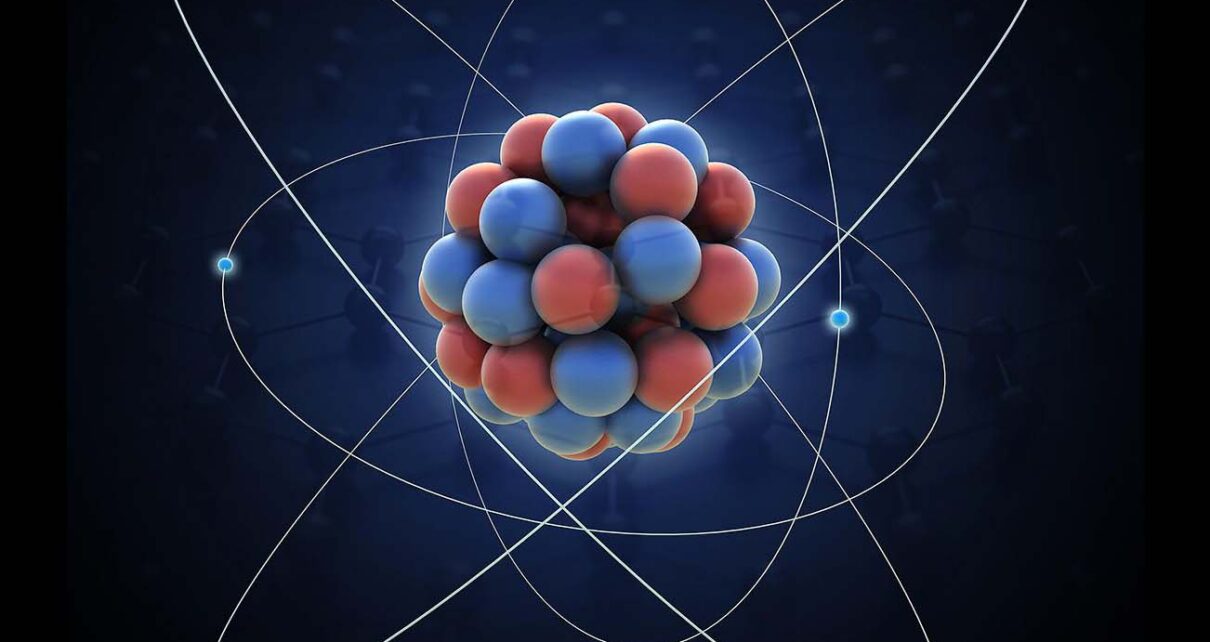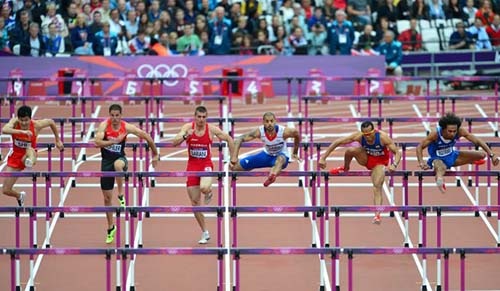
We explain in a simplified way the four most important models in quantum transport: free-electron, tight-binding, Boltzmann and ab-initio. To achieve this, we consider an analogy with athletics, the world’s oldest competitive sport.
We explain in a simplified way the four most important models in quantum transport: free-electron, tight-binding, Boltzmann and ab-initio. To achieve this, we consider an analogy with athletics, the world’s oldest competitive sport.
In a sprint race, the athlete runs from one side to the other without experiencing any obstacle; therefore, to describe it, it will be enough to consider a momentum vector, which will indicate its mass and its velocity.

As shown in Fig. 1, in the 100-meter sprint race, each runner goes through his lane in a straight line without interacting with the others. That is, whatever runner A does, it won’t affect what runner B does. In the language of physicists it is said that there is no interaction between the runners. In the quantum world there is a model that has an analogy with the sprint competition and is known as the free electron model. And in mesoscopic systems – that is, stadiums larger than the size of an atom but still smaller than the thickness of your hair – the sprinters are called conduction electrons. Therefore, in a free-electron model we say that there is no electron-electron interaction. Additionally, when considering stadiums whose tracks are smooth, we can say that there are no impurities that disturb the sprinter, or in the quantum world, there are no electron-impurities interactions.
A 100 meter sprint competition can be described “theoretically” by one runner. For this, in Fig. 1, it will be enough for a single athlete to run 8 times with the momentum values given by the other athletes. This would imply changing the speed and mass of the runner 8 times, something difficult to visualize in the classical world, but if we speak of a “theoretical” model then it is possible. And this is what is done in a quantum study; however, in the quantum world there are not only 8 electrons that run in a mesoscopic system, for practical purposes we say that they are infinite, that is, there are infinite values for the momentum vector. The advantage of the quantum world is that the electrons are indistinguishable particles, i.e., they have the same mass; therefore, the momentum vector can only be associated with its velocity. This vector is defined as p = m v, where m is the mass and v is the velocity vector. In quantum studies, physicists prefer to work with the wave vector k, where p= $\hbar$k. "hbar" is Planck's constant. For practical purposes we choose $\hbar$=1, then we obtain p=k, which will allow us, from now on, to speak indistinctly between the momentum vector and the wave vector.
In the classical world, the slowest runner can be described with a velocity equal to zero, v=0, while the fastest runner can reach a maximum velocity that we will call the Fermi velocity or vF = kF/m. Currently the fastest athlete is Usain Bolt, we can say then that he currently holds the Fermi velocity on the planet. What if Usain Bolt goes to the Moon to run? It is likely that the value of vF will decrease, which means that on the Moon, Bolt would run slower than on Earth, this due to a reduced friction on the Moon. Therefore, the Fermi level is defined by the system in which the athlete competes. In the quantum world we say that the slowest electron has a velocity v=0 and its Fermi velocity is given by vF = kF/m. In the same way that Usain Bolt experiences different velocities either on Earth or on the Moon, the electron also experiences different velocities depending on the system where it is. The difference lies in the fact that at the quantum level we are not talking about the friction of the runner but instead about a change in its mass, that is, the mass of the electron changes depending on the material through which it moves. In the case of the classical world, the mass is constant, of course, as long as Usain Bolt does not lose an arm in an accident.
So far we have mentioned the momentum vector p = k. Considering this vector we can define the kinetic energy of the sprinter or the electron as E = k2/2m, but this is only the kinetic energy, there are other forms of energies that the sprinter or the electron can have. In the quantum world, if we focus on a free-electron model, the total energy of the electron is given solely by the kinetic energy since there are no other forms of interaction. Therefore, if when studying a system we observe that the energy of the electron approaches the square of the vector k then the free-electron model will be sufficient to describe it qualitatively.
In spintronics, for example, a sub-field of condensed matter physics, there is a nanometric system that can be satisfactorily described considering this model, it is known as a magnetic tunnel junction (MTJ), which is made of two ferromagnetic metal layers separated by a non magnetic insulator. In this system, in the magnetic layers the behavior of the electrons can be associated with that of the sprint runners. And in the insulator they experience what we call the tunneling effect, that is, the electrons pass through the insulator preserving the characteristics of a sprint runner. But the free electron model is only an approximation, a more accurate model will require to consider other types of interactions, such is the case of the tight-binding model.

The tight-binding model has an analogy to the hurdle competition, in this case, as seen in Fig. 2, the athletes have to overcome obstacles, or hurdles, which are equally spaced. These hurdles at the quantum level are the atomic potentials of the mesoscopic system, which we will call from now on a crystal, that is, the conduction electrons in a crystal feel the presence of the atoms, and this presence disturbs them in a similar way that the hurdles do to the runners. In the classical world, even in the presence of the hurdles, the runners keep their trajectories, in the quantum world, if we focus on a system that can be described by a one-dimensional model, such as an MTJ, something similar happens. So what difference does it make to consider a free electron model or a tight-binding model? If we imagine running a race with hurdles and then a race without them, we will notice the difference, in the first one we will get more tired than in the second one, that is, the hurdles modify the energy of the runner; therefore, at a quantum level, the electron’s energy will no longer be exactly proportional to the square of the vector k, which implies that the free electron model is actually very inaccurate; however, it is the simplest model and therefore its results can be very useful.
Similar to the sprint race, to get a theoretical picture of the hurdle competition it will be enough to make a single athlete run with different momentum values. At the quantum level this is called the single electron tight-binding model because we only consider one electron and we will make it run many times, or to put it mathematically, we will integrate its result over all possible vectors k.
So far we have ignored the impurities. How does the electron behave in the presence of them? Similar to how you behave when you arrive at a nightclub and have to cross the dance floor to get to the bar and order a drink. On the way, some people, let’s call them impurities, will block your way, others will push you away, and you will end up taking a long and complicated path to reach the bar. This interaction between the electron and the impurity is called scattering, that is, the momentum vector of the electron will undergo a change in direction and magnitude. If there are many impurities in the system, such as people in a nightclub, after a while, the electron will not remember what its initial k vector was and it will only remember its final k vector or do you remember the exact path you took whenever you requested a beer at a nightclub? But in order to have a lot of impurities in a system, it must be relatively large, let’s say 100 times larger than the thickness of the non-magnetic insulator in an MTJ.

But how an impurity can be modeled? The atomic potentials were modeled with hurdles, but these, after all, only disturbed the energy of the electron. Logically, if we want the electron to suffer a severe blow, called scattering, we need a higher hurdle. The simplest way to mathematically model an impurity is by considering a delta function, which resembles as though the electron competes in the pole vault as shown in Fig. 3. In the classical world, the athlete in Fig. 3 uses a mat so that when falling she is still conscious and can remember her initial k-vector. In the quantum world there is no such mat, therefore the electron will lose notion of its initial k-vector after many strokes. This type of free electron model with impurities is called the semi-classical, or quantum, Boltzmann model. The pending question would be, can a tight-binding model consider impurities? Of course. In this case, as you can imagine, it will work with hurdles of different heights, randomly predisposed in the system. This is because one cannot exactly determine the location of the impurities, so what better way to locate them than randomly.
The aforementioned models are the simplest quantum models and therefore they allow to easily understand the physics behind a problem. Of course, we have missed something important and it is the electron-electron interaction. The big problem with considering this interaction and even other types of interaction is that in a crystal the number of electrons is very large, so large that it would take centuries to solve the equation. Therefore, in order to solve it, physicists use super computers, and this model that tries to consider all possible interactions and solve the equation through a super computer is called Density Functional Theory (DFT) or in common language it is known as ab-initio calculations
In conclusion, ab-initio calculations will give us more accurate results. However, the more exact the solution, the more difficult it is to find the cause. Therefore, the 4 models described here, complement to each other and will always be present when it comes to study a quantum system.
Views: 1 Sports
Notifications
Receive the new articles in your email








